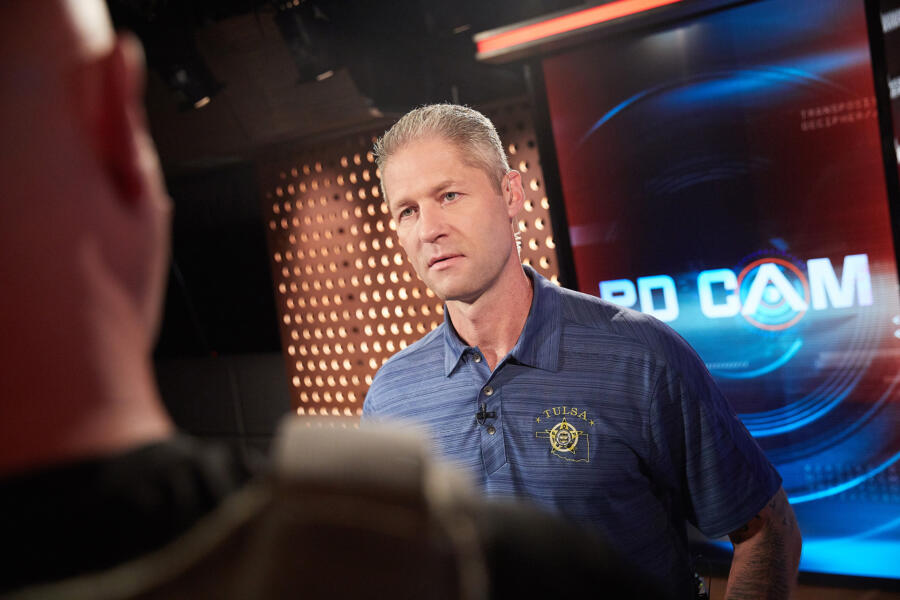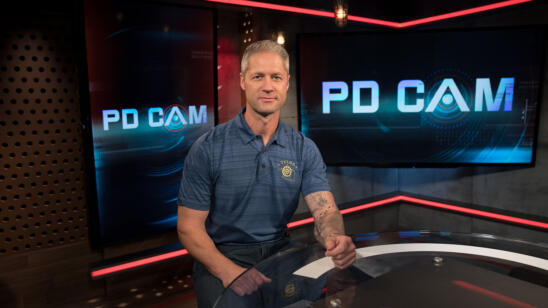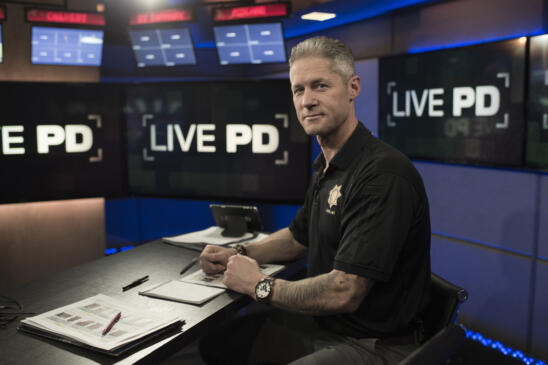Even though the increased use of body cams and dash cams by law-enforcement is a hot topic in the news, stationary-surveillance equipment remains a critical part of police work.
Sgt. Sean “Sticks” Larkin from Live PD and Live PD Presents: PD Cam spoke with A&E True Crime about the use of surveillance by the Tulsa Police Department, whether civilians can request footage from a private business and the funniest things he’s seen caught on camera.
What role does surveillance footage play in your day-to-day work in Tulsa?
Because surveillance is so prevalent now, it’s one of the things the officers at the scene or a crime-scene investigator who responds automatically checks for. In addition to knocking on doors for witnesses, you [ask], ‘Where could a camera be?’ A lot of times, it’s not just the cameras at the scene. You’re looking for anything that might be pointed down the street or could catch the suspect’s vehicle going in and out of the neighborhood. Even [if] the actual incident itself wasn’t caught on there, [it’s] going to help the investigation.
Does someone caught on surveillance have any right to privacy regarding being in the footage?
If you’re out in public, you really can’t have an expectation of privacy. If surveillance videos capture something in the public, [other] people can pretty much put that stuff out there and that’s something, obviously, we see.
How important is surveillance footage and body-cam footage in helping solve crimes?
Nowadays, it’s crucial. When an officer’s testifying in court and says, ‘Hey this whole thing was recorded on my body camera, both the audio and the video,’ it pretty much shuts off [accusations that the officer is lying] at that point. So it’s huge. That’s just for something as simple as traffic stops, but obviously getting confessions from suspects, now that things are caught on body cam and dash cam and audio, is the same type of deal. You get a confession from somebody, verbally, at one point and then you go to court and the person says, ‘I never said that; he’s lying.’
It comes down to whether the jury’s going to believe one side or the other, and now you’ve got this evidence.
How much do these types of footage help you as a refresher regarding a specific incident?
If we have to go to court over a case, [and there was] something we know was caught on there, we make sure we review it before we go in. You’re reviewing it as both a refresher for anything you’re going to see, as well as the conversation you may have had with the suspect, because that’s something you want to be able to introduce in court, on record.
In what ways do different types of surveillance footage help solve crimes?
We pretty much see everything first hand with our own eyes, so the body cam and dash cam just helps for documentation—that’s good for court.
We had a case maybe a month ago where I think two or three people were shot in Tulsa. We were able to identify the different people in the video shooting, strictly because we’re familiar with them and it was caught on surveillance video. In this incident, one guy gets shot, drops his gun, and then another guy—who we know is a gang member—runs and picks the gun up. So we’ve got two convicted felons, on video, with firearms in their hands. So even though we don’t have cooperative victims a lot of the time, we are able to put cases on these guys because of [footage].
As far as investigating crimes, home-surveillance cameras and business cameras are huge. Just this past week, I assigned a case to one of my guys where a gentleman was shot. It was a disturbance at a club. The next day, they go back out to that club because they had surveillance cameras and talk to the owners to get the surveillance videos so we’re able to see what happened.
What’s the funniest thing you’ve seen on surveillance footage?
Some of the stuff on the internet or YouTube [is funny]. I get a kick out of these idiots who try to burglarize businesses or homes. They come in through a roof, and they fall through [it]. All of a sudden you just see this body drop through the ceiling and land on one of the counters or something and it’s like, That’s what they get. I crack up every time.
What about in your own experience?
Recently, a couple of the guys I work with had a foot chase with a guy who took off running. The officer catches up to him, handcuffs him. On the body cam, he rolls him over and pulls out this huge 45-caliber semi-automatic pistol with the hammer cocked back. So that’s all great for evidentiary [purposes]. Then the officer says, ‘You need to get yourself some CrossFit, son.’ He’s kind of making fun of him for getting caught.
What would you say is the most shocking thing you’ve seen by way of surveillance?
If we’re talking body-cam stuff, it was actually featured in the first episode of PD Cam. An officer named Quincy Smith was shot point-blank three times and it was all captured on his camera. As a cop, anytime you see those type of videos, it gets to you. Now that these things are caught on video more and more, the public gets a sense of what the officers are going through—a true layout of what took place. It’s also crucial for trial so the jurors themselves get to see what happened.
How does the Tulsa PD decide where to put cameras?
In Tulsa, our camera system is not like some larger cities. You can get consent from private property owners to do it, but for the most part, they’re going to be put up in intersections where it’s city property, and on telephone poles. When our agency does investigations, if we’ve got a spot where we know there’s gang or drug activity, and we want to put a hidden camera up, we contact the electric company and [contract them to] put it up for us on their property.
Can citizens just ask a private business or property owner for footage?
Yes. And the owners of that surveillance equipment or video can definitely say no. If it is a criminal [case and] police are investigating, then they could go about trying to obtain it through a search warrant if the owners didn’t want to turn it over.
Where do you see surveillance going in the next few years?
From a law-enforcement standpoint, something we will probably see more of, in some communities across the country, is real-time monitoring of surveillance systems. Some of that goes on in the United Kingdom right now. I think we will have the ability, or the infrastructure set up here that people within law enforcement or private contracting companies will be able to monitor things going on in high-crime areas and be able to report [criminal activity] immediately to law enforcement. Then officers can respond to it immediately, rather than wait for the phone call to come in that the suspect’s already gone.
Related Features:
A Surveillance Expert on Planting Bugs in Carpets, Cats and Cockroaches to Nab Suspects


